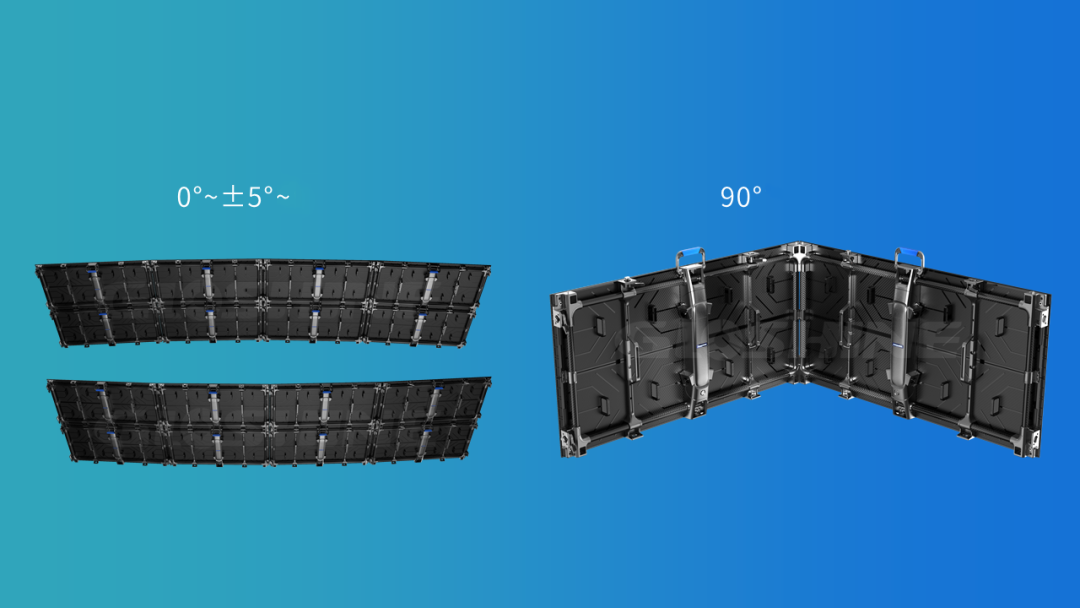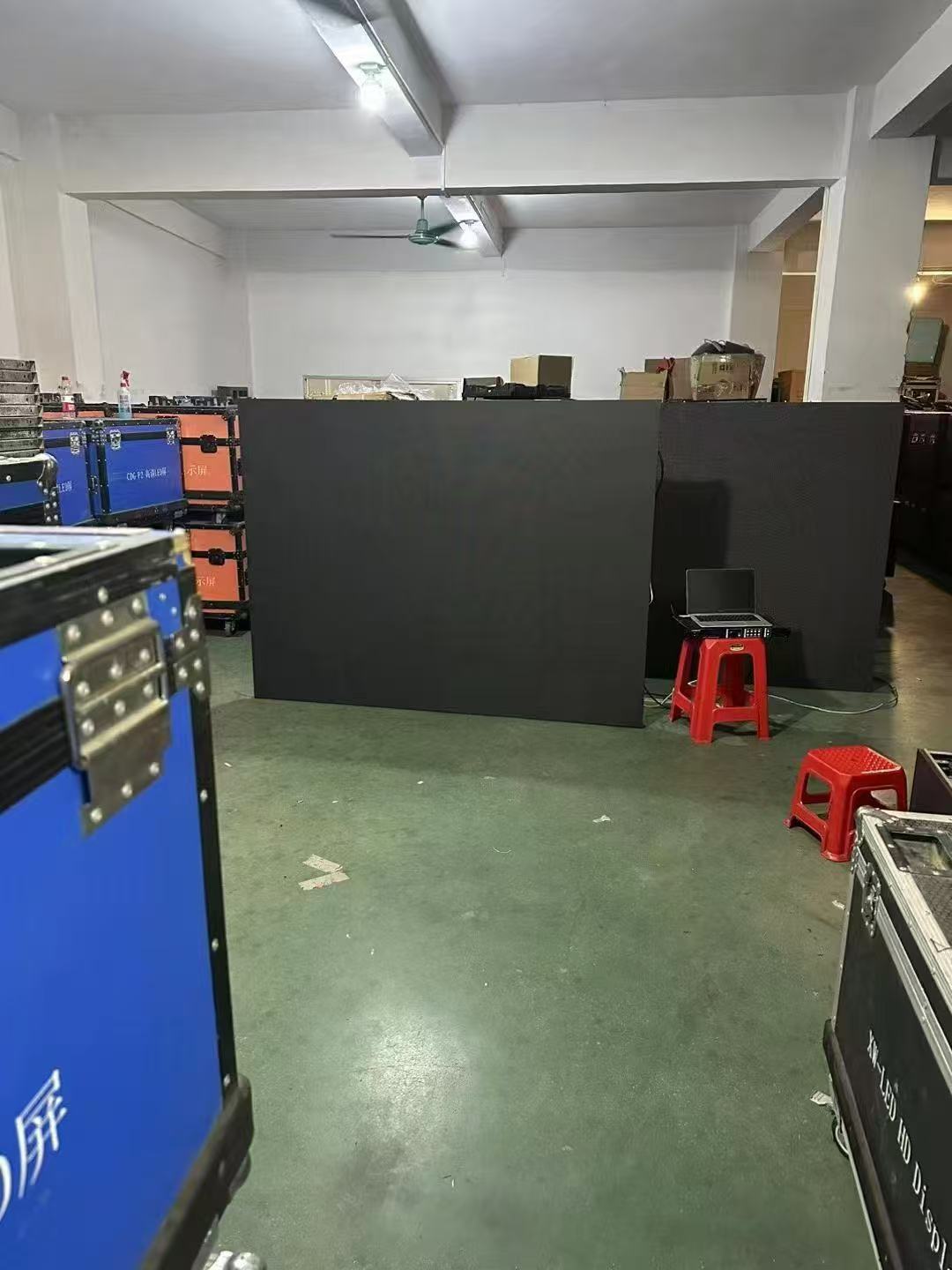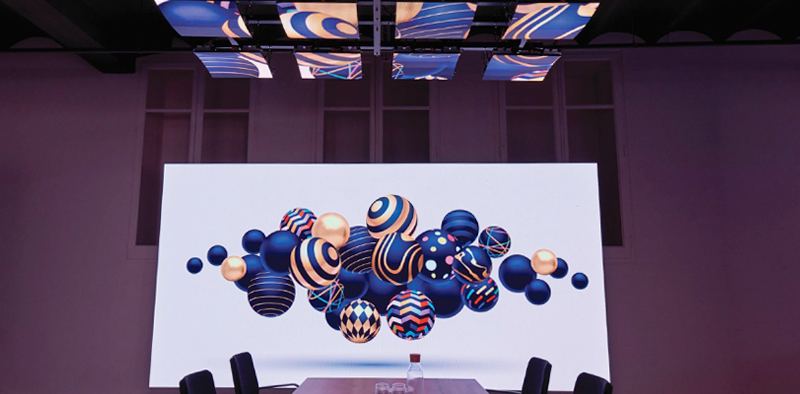When people choose small-pixel LED displays, they can be divided into two options: LED modules and LED cabinets. Some customers may not know the difference between the module and cabinet structures of LED displays. Which one is better? Next, GDHANHENG will analyze it from a professional perspective, hoping to provide you with some help.
Generally speaking, in terms of the overall display effect and the convenience of installation and disassembly, the LED display cabinet is better than the LED module due to the LED cabinet has better flatness, which brings the overall effect of splicing and the integrated display effect of the picture are better.
At the same time, the installation of the cabinet is faster than that of the LED module, because the cabinet is larger in size and easier to disassemble, and will not collide with each other to cause lamp beads. Hence, it is more conducive to the stability of long-term use.
What is an LED module of LED display?
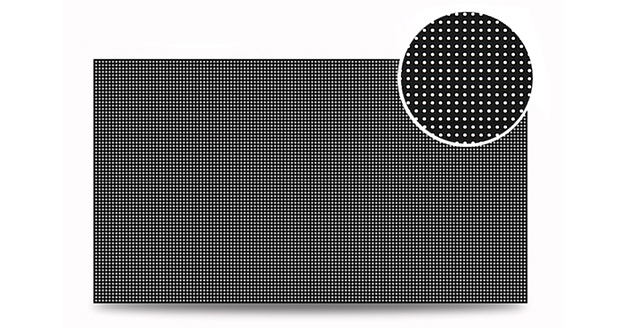
LED display Module is the basic unit that makes up an LED display. A complete LED display is formed by splicing multiple LED modules. Different pixel-pitch LED lamp beads are distributed on the modules. Many modules are spliced together to assemble some large LED displays. For example, indoor P2, P2.5, P3, P4, P5 and other specifications are also mostly made of LED modules.
Advantages and disadvantages of LED display modules:
Here’s the advantages and disadvantages of LED display modules:
| Aspect | Advantages | Disadvantages |
|---|---|---|
| Technology | Mature technology commonly used in both outdoor and indoor LED displays. | – |
| Cost | Low initial installation cost, as well as lower costs for replacement and maintenance. Cheaper to replace individual lamp beads. | – |
| Maintenance | Easier to repair individual lamp beads in case of damage. | – |
| Installation | – | Cumbersome and slow, especially for large projects due to the small size of the modules requiring numerous pieces. |
| Flatness & Gaps | – | Difficult to adjust flatness with potential for fluctuations and gaps between modules, affecting display quality. |
What is an LED display cabinet?
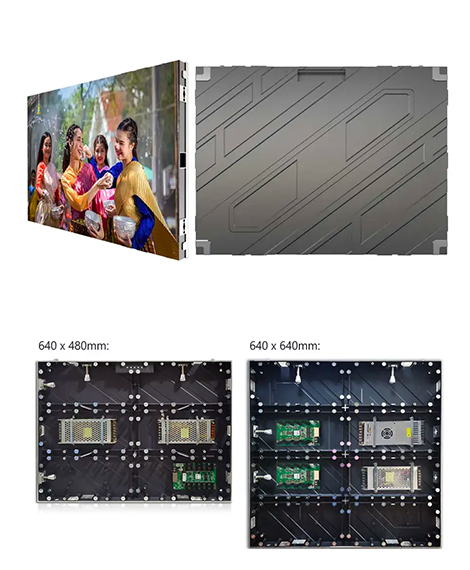
The LED display cabinet is composed of several LED display modules that can be combined and spliced. To meet different environments, coupled with a set of appropriate controllers (main control boards or control systems), display boards (or unit boxes) of various specifications,it can form many kinds of LED displays.
Type of Cabinets
| Feature | Iron Cabinet | Die-Cast Aluminum Cabinet | Carbon Fiber Cabinet | Magnesium Alloy Cabinet | Nano Polymer Material Cabinet |
|---|---|---|---|---|---|
| Weight | Heavy | Light | Ultra-light | Lighter than aluminum, heavy compared to carbon fiber and nano polymer | Very light |
| Strength | Insufficient | High | High, with a tensile strength of 1500kg | Greater impact load capacity than aluminum alloy | Shock and drop resistant |
| Precision | Poor | High, allows for seamless splicing | High, allows for 90-degree splicing | Good | Good |
| Design | Good sealing | Compact, seamless, humanized design for easy installation | Ultra-thin, fully modular, non-transparent backplane | Compact, excellent heat dissipation | Shock resistant design |
| Installation | Generally used outdoors | Easy, convenient, with concealed connections | Easy, modular design for convenient maintenance | Easy, good heat dissipation | Easy to load and unload, light to carry |
| Material | Iron | Aluminum | Carbon Fiber | Magnesium Alloy | Nano Polymer Materials |
| Cost | Affordable | Higher than iron, cost-effective | Not specified, likely higher due to advanced materials | Cost-effective, excellent features for price | Cheaper than die-cast aluminum, low transportation costs |
| Application | Outdoor large screens | Indoor rental displays, seamless splicing applications | Sports venues, outdoor advertising lights | Wide range due to strength and heat dissipation | Not specified, likely versatile due to light weight and cost-effectiveness |
Introduce the LED screen Cabinet IP level
From the above we know that LED screens can be used in different locations and require different types of cabinets, and LED cabinets need strong performance and protection to protect them from external damage. In order to assess the protection performance of LED screens, an IP rating system has been introduced.
The IP (Ingress Protection) rating comprises two digits:
- The first digit signifies the level of protection against solid objects or materials.
- The second digit indicates the level of protection against liquids.
For instance, an IP rating of 54 indicates a level 5 protection against solid objects and a level 4 protection against liquids. An “X” in place of either digit (e.g., IPX1) signifies that the product is rated for protection against one type of ingress but not the other.
Here’s a breakdown of the IP classification system:
Classification of Protection Against Solid Objects:
| Rating | Protection Level |
|---|---|
| 0 | No protection |
| 1 | Protection against solid objects over 50 mm. No protection against touch |
| 2 | Protection against solid objects over 12 mm, such as fingers |
| 3 | Protection against solid objects over 2.5 mm (tools, wires) |
| 4 | Protection against solid objects over 1 mm (small tools, wires) |
| 5 | Dust-protected. Complete protection against contact |
| 6 | Dust-tight. Full protection against dust and contact |
Classification of Protection Against Liquids:
| Rating | Protection Level |
|---|---|
| 0 | No protection |
| 1 | Protection from vertically falling water drops, e.g., condensation |
| 2 | Protection against direct vertical jets of water up to 15° |
| 3 | Protection against direct vertical jets of water up to 60° |
| 4 | Protection from water sprays from any direction |
| 5 | Protection from low-pressure jets of water from all directions |
| 6 | Protection from strong jets of water, suitable for use on ship decks |
| 7 | Protection against short-term immersion in water up to 1 meter depth |
| 8 | Protection against prolonged immersion in water up to 1 meter depth |
| 9 | Protection against prolonged immersion under pressure |
LED cabinet maintenance is critical to the longevity of your LED screen, and you can choose to access it from the front or the back.
- While Front-access LED modules more complex and costly, it can be mounted close to the wall on slender frames.
- In contrast, rear back LED screens are often mounted on back with enough space.
Currently, the small pixel LED displays cabinet are basically below P2, such as P1.86, P1.53, P1.25, and P0.9 etc, especially for COB packaged LED displays.
More:
P2 Vs. P3 LED wall
Advantages and disadvantages of LED cabinets
| Aspect | Advantages | Disadvantages |
|---|---|---|
| Installation | Large size makes splicing simple; just stack cabinets and adjust seams easily. | |
| Flatness | Better adjustment due to large size; results in even and improved display. | |
| Maintenance | Designed for easy disassembly, especially useful for temporary setups. | |
| Cost | Higher price compared to individual LED modules at same pixel pitch. |
The differences between LED display modules and cabinets
The main differences between LED display modules and cabinets are size, pixel pitch, flatness after installation and price.
Size difference
Usually, the size of the LED module is relatively small. The current mainstream LED display modules are 160mm*160mm, 320mm*320mm, etc., while the size of the LED cabinet is relatively large, such as the mainstream small-pitch LED display cabinets are 480mm*480mm, 600mm*337.5mm, etc. The latter size is more popular with customers because the ratio of this size is designed to be 16:9, making it easier to maintain the conventional display ratio of the entire LED display.
The difference between pixel pitch
Most of the LED displays composed of LED modules have large pixel pitches that are basically between P2~P20, while the LED display cabinets are mostly used in indoor small-pitch LED displays, mainly used for below P2.
Difference in flatness
Since the size of the cabinet is larger, when it is installed into a large-size LED display, the flatness of the LED display spliced out of the cabinet is better, while the seams and concavity of the LED module splicing are often difficult to control. , which will directly affect the later display effect.
The difference in convenience between installation and disassembly
The board size of the LED module is relatively small, so the installation is slow and requires splicing piece by piece. The large size of the cabinet makes it more convenient to install, and it is also more convenient to disassemble and repair later.
Price difference
In the composition of some small-pitch LED displays, you can choose to use cabinets or modules. For example, P2, P1.8, P1.5, etc. can also use modules, and choose to use modules. The price of the LED module will be cheaper than the LED cabinet. For some occasions with limited budget, the module will be more cost-effective.
| Criteria | LED Module | LED Cabinet |
|---|---|---|
| Size | Smaller sizes (e.g., 160mm160mm, 320mm320mm) | Larger sizes (e.g., 480mm480mm, 600mm337.5mm) |
| Pixel Pitch | Larger pixel pitches (P2~P20) | Smaller pixel pitches (below P2) |
| Flatness | Difficult to control, may affect display quality | Better flatness, resulting in a higher quality display |
| Installation/Disassembly | Time-consuming installation, piece by piece | More convenient and faster, easier to repair |
| Price | Cheaper, cost-effective for limited budgets | More expensive, may offer better performance and ease of maintenance |
Conclusion:
The LED display cabinet has been gradually applied to the market in recent years. It is mainly used in the composition of small-pitch LED displays, especially P1.8, P1.5, P1.25, P0.9, etc. It is more convenient to install and disassemble, and has better flatness. While the price of modules is relatively low but not to easy install. When designing, the choice of whether to use an LED display cabinet or a module mainly depends on the LED display pixel pitch and other factors such as whether it is frequently disassembled and the budget.
